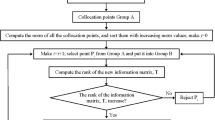Abstract
To solve spectral stochastic finite element problems, the collocation-based spectral stochastic finite element method (SSFEM) was developed, and the Stochastic Response Surface Method (SRSM) was used to represent uncertainty propagation. Therefore, the accuracy of SRSM is important for obtaining more accurate probabilistic results. The weighted SRSM was developed to improve the global accuracy of SRSM, but it is not suitable for random field problems because weights might distort the response surface. In this study, a new Stochastic Dual-response Surface Method (SDRSM) was developed to improve the accuracy of SRSM. The SDRSM combines the conventional SRSM and target-weighted SRSM (TWSRSM), which is assigned a weight for the numerical result corresponding to the collocation point. Then, the proposed method was extended to deal with problems involving random fields. For comparison with the conventional methods (SRSM and WSRSM), two numerical examples involving random fields were carried out. Compared with Monte Carlo simulation results, SDRSM shows the smallest error without the addition of the collocation points. In addition, the mean absolute errors for equally spaced probability intervals were compared, and their mean and standard deviation of SDRSM were relatively smaller than that of other methods.
Similar content being viewed by others
References
Adomian, G. (1994). Solving Frontier Problems of Physics: The Decomposition Method, Kluwer, Boston.
Arregui-Mena, J. D., Margetts, L., and Mummery, P. M. (2016). “Practical application of the stochastic finite element method.” Arch. Comput. Method E., Vol. 23, No. 1, pp. 171–190, DOI: 10.1007/s11831-014-9139-3.
Blatman, G. and Sudret, B. (2011). “Adaptive sparse polynomial chaos expansion based on least angle regression.” J. Comput. Phys., Vol. 230, No. 6, pp. 2345–2367, DOI: 10.1016/j.jcp.2010.12.021.
Bellomo, N. and Riganti, R. (1987). Nonlinear Stochastic Systems in Physics and Mechanics, World Scientific, Singapore.
Belytschko, T., Organ, D., and Krongauz, Y. (1995). “A coupled finite element-element-free Galerkin method.” Comput. Mech., Vol. 17, No. 3, pp. 186–195, DOI: 10.1007/BF00364080.
Benaroya, H. and Rehak, M. (1987). “Parametric random excitation. I: Exponentially correlated parameters.” J. Eng. Mech., Vol. 113, No. 6, pp. 861–874, DOI: 10.1061/(ASCE)0733-9399(1987)113:6(861).
Do, D. M., Gao, W., and Song, C. M. (2016). “Stochastic finite element analysis of structures in the presence of multiple imprecise random field parameters.” Comput. Methods Appl. Mech. Engrg., Vol. 300 (2016) pp. 657–688, DOI: 10.1016/j.cma.2015.11.032.
Drakos, S. and Pande, G. N. (2016). “Stochastic finite element analysis using polynomial Chaos.” Studia Geotechnica et Mechanica, Vol. 38, No. 1, pp. 33–43, DOI: 10.1515/sgem-2016-0004.
Ghanem, R. G. and Spanos, P. D. (1991). Stochastic Finite Elements: A Spectral Approach, Springer, New York.
Ghosh, D. and Iaccarino, G. (2007). “Applicability of the spectral stochastic finite element method in time-dependent uncertain problems.” Annual Research Briefs 2007, pp. 133–141.
Grigoriu, M. (2006). “Evaluation of Karhunen-Loève, spectral and sampling representations for stochastic processes.” J. Eng. Mech., Vol. 132, No. 2, pp. 179–189, DOI: 10.1061/(ASCE)0733-9399 (2006)132:2(179).
Hemanth, G., Vinoy, K. J., and Gopalakrishnan, S. (2014). “Spectral stochastic finite element method for periodic structure.” 2014 IEEE International Microwave and RF Conference (IMaRC), pp. 9–12, DOI: 10.1109/IMaRC.2014.7038959.
Huang, S., Mahadevan, S., and Rebba, R. (2007). “Collocation-based stochastic finite element analysis for random field problems.” Probabilist. Eng. Mech., Vol. 22, No. 2, pp. 194–205, DOI: 10.1016/j.probengmech.2006.11.004.
Isukapalli, S. S., Roy, A., and Georgopoulos, P. G. (1998). “Stochastic Response Surface Methods (SRSMs) for uncertainty propagation: application to environmental and biological systems.” Risk. Anal., Vol. 18, No. 3, pp. 351–363, DOI: 10.1111/j.1539-6924.1998.tb01301.
Jahedi, A. and Ahmadi, G. (1983). “Application of Wiener–Hermite expansion to nonstationary random vibrations of a Duffing Oscillator.” J. Appl. Mech., Vol. 50, No. 2, pp. 436–442, DOI: 10.1115/1.3167056.
Kaminski, M. (2013). The Stochastic Perturbation Method for Computational Mechanics, John Wiley & Sons, New Jersey.
Myers, R. H. and Montgomery, D. C. (1995). In: Response surface methodology: Process and product optimization using designed experiments, John Wiley & Sons, New Jersey.
Pascual, B. and Adhikari, S. (2012). “A reduced polynomial chaos expansion method for the stochastic finite element analysis.” Sadhana, Vol. 37, No. 3, pp 319–340, DOI: 10.1007/s12046-012-0085-1.
Pukl, R., Jansta, M., Cervenka, J., Vorechovský, M., Novák, D., and Rusina, R. (2006). “Spatial variability of material properties in nonlinear computer simulation.” Proceedings of the EURO-C Conference, Mayrhofen, Austria, pp. 891–896.
Spanos, P. D., Beer, M., and Red-Horse, J. (2007). “Karhunen–Loéve Expansion of Stochastic Processes with a Modified Exponential Covariance Kernel." J. Eng. Mech., Vol. 133, No. 7, pp. 773–779, DOI: 10.1061/(ASCE)0733-9399(2007)133:7(773).
Spanos, P. D. and Ghanem, R. G. (1989). “Stochastic finite element expansion for random media.” J. Eng. Mech., Vol. 115, No. 5, pp. 1035–1053, DOI: 10.1061/(ASCE)0733-9399(1989)115:5(1035).
Stefanou, G. (2009). “The stochastic finite element method: Past, present and future.” Comput. Methods Appl. Mech. Eng., Vol. 198, Nos. 9–12, pp. 1031–1051, DOI: 10.1016/j.cma.2008.11.007.
Stefanou, G. and Papadrakakis, M. (2007). “Assessment of spectral representation and Karhunen–Loève expansion methods for the simulation of Gaussian stochastic fields.” Comput. Methods Appl. Mech. Eng., Vol. 196, Nos. 21–24, pp. 2465–2477, DOI: 10.1016/j.cma.2007.01.009.
Sudret, B. and Der Kiureghian, A. (2000). Stochastic finite element methods and reliability: A state-of-the-art Report, Technical Report on UCB/SEMM-2000/08, Department of Civil and Environmental Engineering, UC Berkeley.
Tatang, M. A. (1995). Direct Incorporation of Uncertainty in Chemical and Environmental Engineering Systems, PhD Thesis, Massachusetts Institute of Technology.
Vanmarcke, E. and Grigoriu, M. (1983). “Stochastic finite element analysis of simple beams.” J. Eng. Mech., Vol. 109, No. 5, pp. 1203–1214, DOI: 10.1061/(ASCE)0733-9399(1983)109:5(1203).
Villadsen, J. and Michelsen, M. L. (1978). Solution of differential equation models by polynomial approximation, Prentice-Hall, Englewood Cliffs, New Jersey.
Xiong, F., Chen, W., Xiong, Y., and Yang, S. (2011). “Weighted stochastic response surface method considering sample weights.” Struct. Multidiscip. Optim., Vol. 43, No. 6, pp. 837–849, DOI: 10.1007/s00158-011-0621-3.
Author information
Authors and Affiliations
Corresponding author
Rights and permissions
About this article
Cite this article
Bong, T., Son, Y. A Stochastic Dual Response Surface Method for Reliability Analysis Considering the Spatial Variability. KSCE J Civ Eng 22, 3524–3533 (2018). https://doi.org/10.1007/s12205-018-0803-2
Received:
Revised:
Accepted:
Published:
Issue Date:
DOI: https://doi.org/10.1007/s12205-018-0803-2




